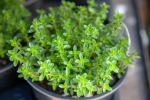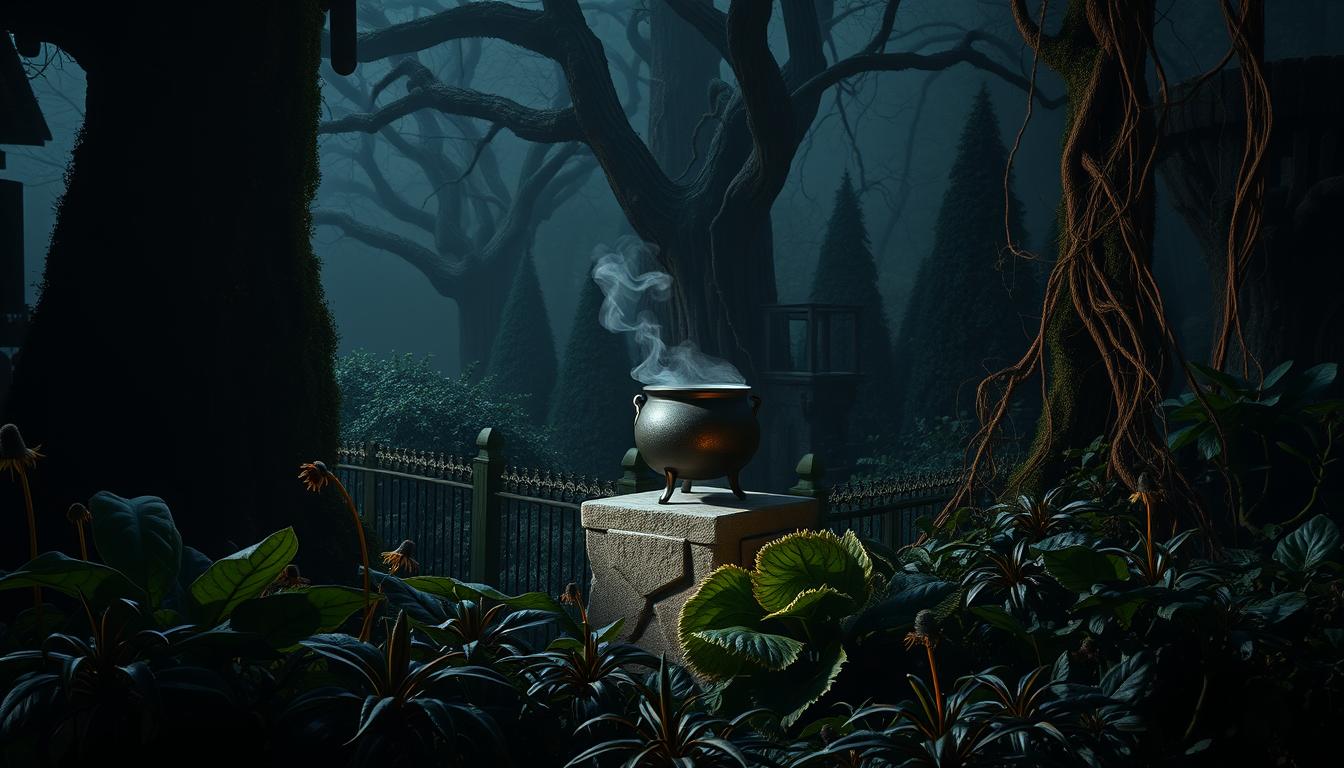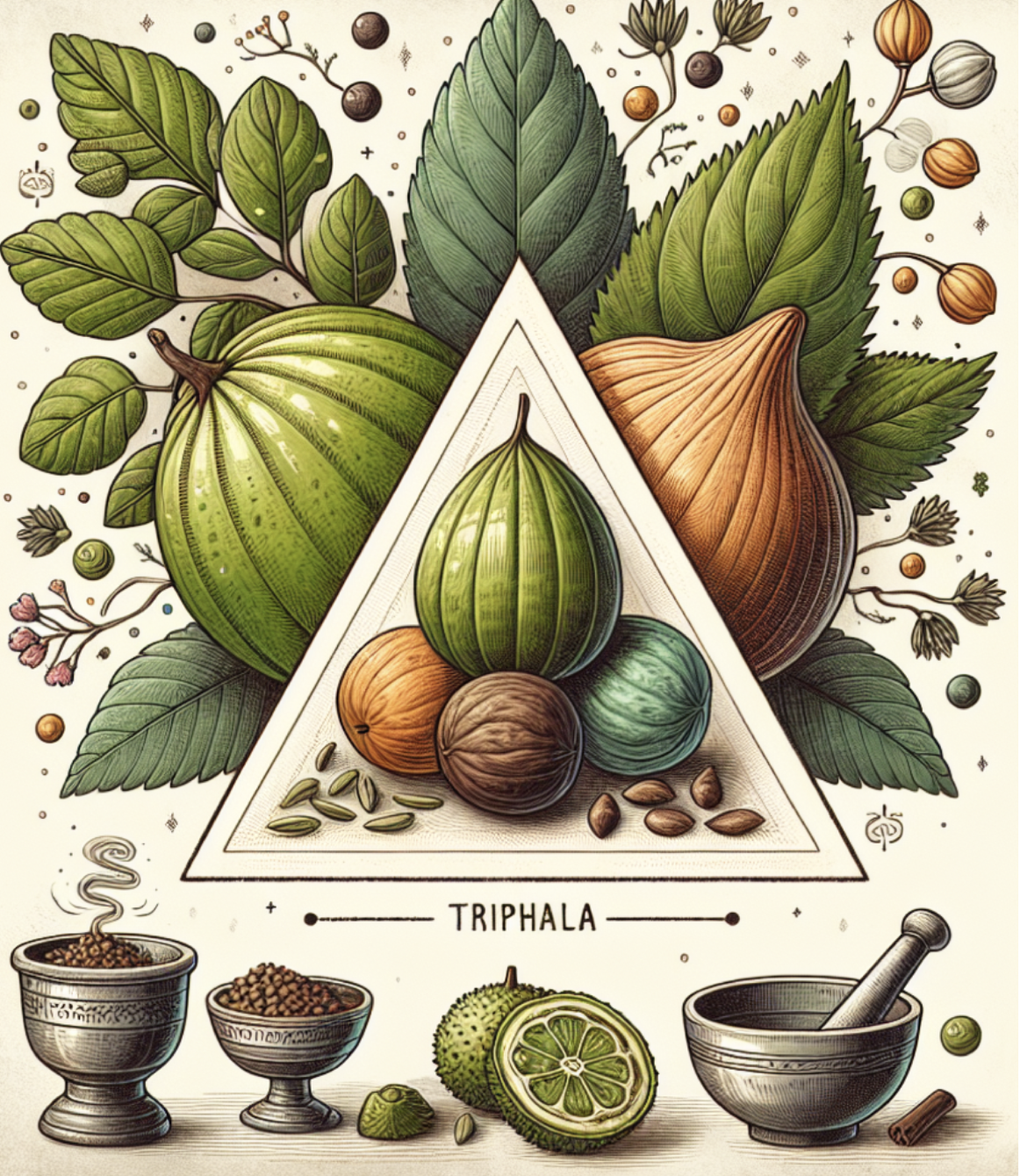In recent years, the Harry Potter books have sparked a fun interest in herbs and their uses in potions and incantations, etc. This week, in the spirit of Halloween, I decided to research how herbs can be incorporated in a “magical” garden. I had a lot of fun researching this article and hope you’ll enjoy it too.
Ever wondered how ancient herbalists turned ordinary plants into legendary remedies? This article peels back the curtain on folklore to reveal the real greenery behind mystical brews. Whether you’re a curious gardener or a history buff, you’ll discover how to blend tradition with modern creativity.
Historical “magic” potions weren’t just fairy tales—they relied on herbs like lavender, mint, and chamomile. These plants were cherished for their soothing properties, often used in teas or salves. Today, they’re perfect for crafting a witch garden that’s equal parts sanctuary and science lab.
Building a sacred space isn’t just about aesthetics. As seasoned practitioners emphasize, it’s about respecting nature’s rhythms. Think of your plot as a living canvas—add symbols, art, or seasonal blooms to reflect your intentions.
Ready to create a witch garden of your own? We’ll guide you from selecting meaningful flora to designing layouts that honor both past and present. Let’s dig into the roots of herbal lore and grow something magical together!
Introduction to Your Magical Gardening Journey
What if your garden could be more than just plants—it could be a portal to magic? Whether you’re tending a sprawling backyard or a windowsill planter, every garden holds potential to become a sacred place where earth and energy intertwine. This journey blends dirt-under-your-nails gardening with moonlit rituals, letting you craft a living sanctuary that reflects your unique spirit.
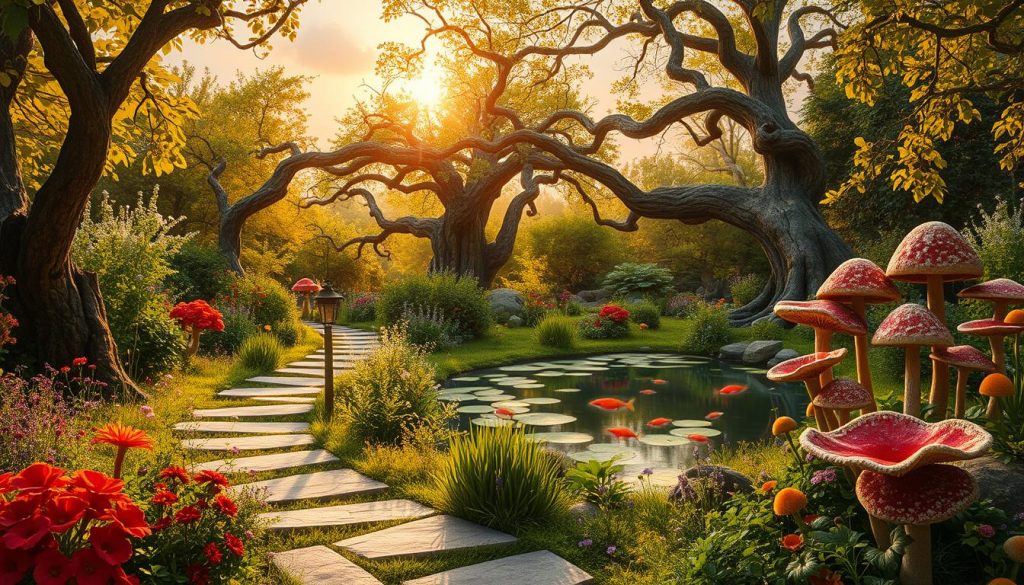
Even small spaces thrive as witch garden hubs. A single herb pot or vertical walls of trailing ivy can channel nature’s whispers. Historical herbalists knew this secret: plants like rosemary and thyme weren’t just seasonings—they were tools for protection, healing, and connection. Today, your plot becomes a canvas for both folklore and creativity.
| Element | Traditional Use | Modern Twist |
|---|---|---|
| Moon Phases | Planting by lunar cycles | Smartphone reminders for rituals |
| Herb Bundles | Protection charms | Aromatherapy sachets |
| Garden Shapes | Sacred circles | Upcycled spiral planters |
Your witch garden starts with intention. Maybe you’ll grow calming lavender for tea or fiery marigolds to energize your body. Later sections will explore layouts and plant pairings, but first—breathe life into your vision. After all, the best gardens aren’t just grown… they’re conjured.
Historical Roots and Folklore of the Witch’s Garden
Long before pharmacies lined city streets, healers turned to the earth’s green bounty for cures and connections. Ancient gardens blended medicine with mysticism—think rosemary for memory or mugwort for prophetic dreams. These spaces weren’t just plots; they were living libraries of plant wisdom passed through generations.
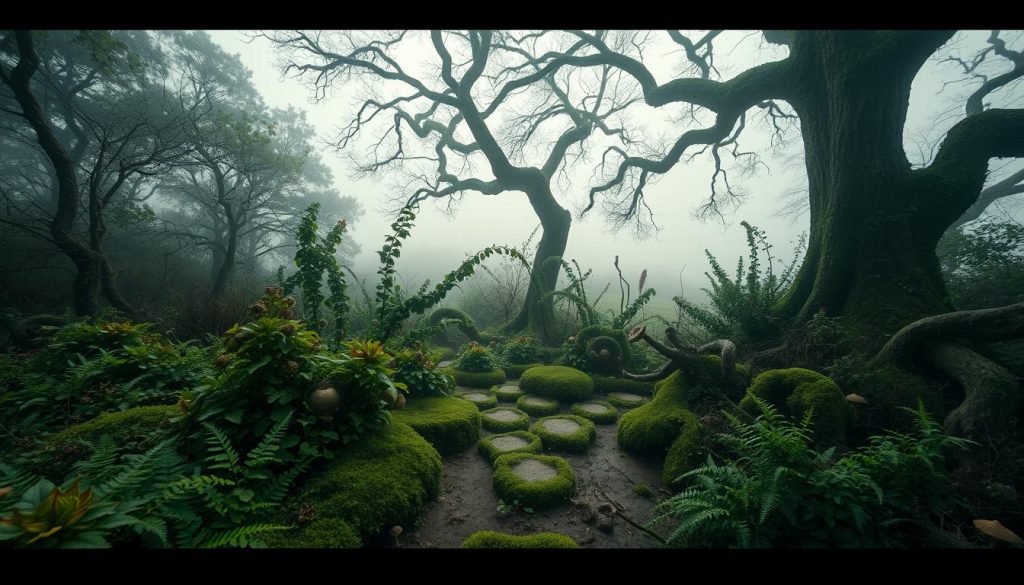
Ancient Legends and Herbal Traditions
Folklore paints witch gardens as places where mandrake roots screamed and belladonna opened spiritual gateways. In reality, medieval “wise women” grew chamomile for fevers and yarrow for wounds. Protective deities like Hecate were honored with bay laurel shrines, merging botany with belief.
May Day celebrations reveal this bond. Villagers danced around hawthorn trees, believing their blossoms attracted fairies. Even dangerous plants like henbane had roles—used sparingly in pain-relief salves despite their toxicity.
Evolution from Folk Remedies to Modern Magic
Today’s green witches blend old ways with fresh creativity. Lavender still calms nerves, but now fills meditation pillows alongside CBD oils. Check out how traditions transformed:
| Element | Ancient Practice | Modern Adaptation |
|---|---|---|
| Protective Shrines | Stone altars for woodland spirits | Fairy gardens with miniatures |
| Mandrake Roots | Ritual hallucinogens | Stress-relief tinctures |
| May Day | Fertility dances | Garden yoga at dawn |
Whether you’re brewing immunity teas or arranging crystals among herbs, you’re part of a story that began when humans first buried seeds with whispered hopes. The magic grows when we honor its roots.
Planning and Designing Your Witch’s Garden
Your garden’s design shapes its magic as much as the plants themselves. Before digging, sketch a plan that mirrors your intentions. Whether you’re crafting a sanctuary for meditation or a hub for herbal remedies, thoughtful layout choices amplify energy flow and practicality.
Sketching Your Layout and Space Considerations
Start by mapping sunlight patterns and soil quality. Use chalk or grid paper to outline organic curves instead of rigid lines. Even small spaces thrive with vertical walls of trailing ivy or stacked herb spirals. Prioritize areas for functional gardening (like a kitchen herb corner) alongside artistic features like stone labyrinths.
| Traditional Element | Modern Adaptation |
|---|---|
| Circular herb beds | Spiral planters from reclaimed bricks |
| Moon phase alignment | Smartphone apps tracking lunar cycles |
| Bare stone altars | Upcycled wood shelves for crystals |
Incorporating Circular and Organic Garden Shapes
Curved pathways and rounded beds create natural energy flow. Try a crescent-shaped plot for moon-loving flowers like evening primrose. Herb spirals maximize space while adding visual intrigue. Align these shapes with seasonal shifts—plant quick-growing basil in spring’s waxing moon phase.
Use weathered wood or mossy stones for borders to blend with nature. Remember: your design is as unique as your magic. Experiment freely—there’s no “wrong” way to grow enchantment.
Selecting Real Plants for Magical Potions
Crafting potions starts with choosing the right green allies. Every plant holds unique energy—some heal, others protect, and a few demand cautious respect. Let’s explore how to curate your botanical toolkit safely and intentionally.
Healing Herbs and Spellbound Botanicals
Classic herbs like sage and rosemary form the backbone of mystical gardens. Sage purifies spaces, while rosemary boosts memory—perfect for study nooks. Mint attracts prosperity, and lavender calms restless minds. Pair these with moonflower vines for nighttime rituals.
| Plant | Magical Use | Growing Tip |
|---|---|---|
| Sage | Cleansing negativity | Full sun, dry soil |
| Mugwort | Enhancing dreams | Partial shade |
| Calendula | Manifesting joy | Deadhead blooms |
Safety First: Managing Toxic and Poisonous Varieties
Foxglove and deadly nightshade have potent properties but require gloves and clear labeling. Always separate edible herbs from toxic ones—use raised beds or distinct containers. Research your region’s native species to avoid invasive plants.
Local nurseries often stock safer alternatives. For example, swap toxic mandrake for non-poisonous comfrey root in salves. Remember: magic thrives when we honor nature’s boundaries.
Implementing DIY Garden Rituals and Practices
Transform your green space into a living ritual with simple, meaningful acts. Even a single pot of basil can become a focal point for intention when paired with thoughtful practices. Let’s explore how to weave magic into daily gardening routines.
Setting Up Garden Shrines and Offerings
Create a small altar using a flat stone or weathered wood stump. Add seasonal plants, crystals, or handmade symbols. Offerings like honey for bees or crushed eggshells for soil health honor nature’s cycles.
Traditional shrines often included birch twigs for protection. Try hanging a bundle above your workspace. Sprinkle salt water around beds to deter pests—a practical twist on ancient cleansing rites.
Moon Phases and Ritual Timing for Planting
Sync your work with lunar energy for stronger growth. Here’s a quick guide:
| Moon Phase | Activity | Magical Boost |
|---|---|---|
| Waxing | Plant leafy greens | Manifestation energy |
| Full | Harvest flowers | Charge moon water |
| Waning | Prune/weed | Release negativity |
Leave a bowl of water under moonlight overnight. Use it to hydrate seedlings—it’s like giving plants a celestial vitamin boost!
Remember: Magic thrives in consistency. Water your herbs while visualizing healing intentions. Whisper thanks to earthworms turning soil. Your witch garden becomes sacred through these tiny, repeated acts.
Creating Enchanted Garden Art and Symbolic Features
Art transforms ordinary spaces into realms where magic feels tangible. By weaving sculptures and symbols into your green sanctuary, you create focal points that channel energy and spark imagination. These pieces act as bridges between the physical world and the stories we carry in our hearts.
Statues, Mirrors, and Whimsical Ornaments
Guardian statues like stone dragons or fairy figurines add layers of meaning to your garden. Place them near entrances to symbolize protection, or tuck them among plants to surprise visitors. Mirrors amplify light and create illusions of depth—just angle them away from direct sunlight to avoid scorching leaves.
| Art Element | Purpose | Placement Tip |
|---|---|---|
| Animal Statues | Invoke specific energies (owls for wisdom) | Nestle under trees for natural harmony |
| Mosaic Stepping Stones | Guide foot traffic mindfully | Use recycled glass for shimmer |
| Wind Chimes | Enhance soundscapes | Hang near seating areas |
| Miniature Shrines | Honor nature spirits | Shelter under broad-leafed herbs |
Reflective surfaces work best in shaded corners where they bounce soft light onto ferns or moss. For families, try painting rocks with children to mark seasonal changes—a pumpkin in fall, a snowflake in winter. These playful touches keep the space feeling alive and accessible.
Balance artistry with practicality. A wrought-iron trellis supports climbing roses while casting lace-like shadows. Upcycle teacups as bird feeders or turn old boots into quirky planters. Every piece should whisper your unique story into the garden’s breeze.
Tips for Native Plants and Attracting Wildlife
Imagine your green space buzzing with life—pollinators darting between blooms, toads sheltering under leaves, and birds nesting in cozy corners. By choosing native plants, you create a thriving ecosystem that sustains local wildlife while amplifying your garden’s magic. Species like milkweed and purple coneflower attract bees butterflies, while berry bushes feed hungry songbirds.
Building Bug Hotels and Creature Features
Invite beneficial insects with DIY habitats. Stack untreated wood, bamboo stalks, and pinecones in a weathered crate to create a bug hotel. Position it near flowering plants for easy pollinator access. For larger creatures:
| Feature | Materials | Wildlife Supported |
|---|---|---|
| Toad Abode | Upturned clay pot with entry hole | Amphibians |
| Bat Box | Untreated wood, dark exterior paint | Mosquito-eating bats |
| Bird Shelter | Gourd houses hung from walls | Wrens and chickadees |
Vertical structures add charm and function. Train native vines like trumpet creeper on woven willow fences—bees adore their tubular flowers. Hang chained baskets filled with nesting materials for birds.
Balance cultivated areas with wild zones. Let a corner grow unruly with goldenrod and asters. This way, your witch garden becomes both sanctuary and sustainable habitat. Remember: Magic flourishes when we work with nature, not against it.
Witch’s Garden: Cultivating Herbs and Edibles for Magic
Your kitchen windowsill holds more power than you think—it’s a launchpad for both meals and magic. By blending edible plants with ritual ingredients, you create a living pantry that nourishes body and spirit. Let’s explore how to grow versatile greens that pull double duty in recipes and spells.
Kitchen Witchcraft Essentials and Home Remedies
Start with basil and thyme—these kitchen staples repel pests while attracting prosperity. Lemon balm makes uplifting teas and stress-relief sachets. Always label herbs like deadly nightshade clearly if grown for symbolic use.
Try this space-saving setup:
| Edible | Magical Pairing | Container Size |
|---|---|---|
| Cherry tomatoes | Rosemary for protection | 12″ pot |
| Nasturtiums | Marigolds for joy | Hanging basket |
| Mint | Lavender for calm | Self-watering box |
Merging Edibles with Traditional Spell Ingredients
Grow calendula petals for salad toppings and love-drawing baths. Chives planted near roses boost growth while storing lunar energy. For family-friendly magic, let kids paint herb markers with emoji symbols.
Companion planting works wonders. Sage shields cabbage from moths, while dill attracts swallowtail butterflies. Even your compost becomes magical—bless it during full moons to accelerate nutrient-rich soil creation.
Remember: Every salad fork can stir intentions. Every rosemary sprig flavors roasted veggies and clears negative energy. Your garden becomes a bridge between sustenance and sacred practice.
Seasonal Maintenance, Environmental Care, and Magical Rituals
Your green sanctuary thrives when care aligns with nature’s heartbeat. Through shifting seasons, blend earth-friendly habits with mindful rituals to nurture both plants and spirit. This way, every watering can becomes a tool for growth and grounding.
Year-Round Care and Practical Gardening Tips
Spring wakes the garden with composting and seed-starting. Bury banana peels near roses for potassium boosts. Summer demands water wisdom—collect rainwater in painted barrels and add moon-charged quartz for healing hydration.
| Season | Task | Magical Touch |
|---|---|---|
| Fall | Mulch beds | Bury protective sigils |
| Winter | Prune dormant plants | Hang cinnamon stick charms |
Eco-care starts underground. Brew compost tea with nettle and chamomile to feed soil microbes. For pests, sprinkle crushed eggshells instead of chemicals—they deter slugs while adding calcium.
Time tasks to lunar rhythms. Plant root vegetables during waning moons and leafy greens when the moon waxes. Draw salt circles around tender sprouts to shield them from frost.
Remember: Tending your witch garden is active meditation. Whisper gratitude while deadheading flowers. Watch bees butterflies dance among blooms—your care sustains this magical space.
Conclusion
Every leaf and bloom in your green space carries centuries of wisdom. By blending historical herbal traditions with modern gardening techniques, you’ve created more than a plot—it’s a living story. From moonlit rituals to nutrient-rich vegetables, your witch garden nourishes both body and spirit.
Let your plants evolve with your journey. Swap toxic species for native flowers, or design spiral herb beds that dazzle neighbors. Whether crafting teas for healing or building fairy houses with children, this space reflects your unique magic.
Remember: Growing beauty requires care. Test soil like medieval herbalists did, but use compost instead of spells. Share cuttings with friends to spread green joy. Your garden isn’t just a hobby—it’s a pact with the earth. Keep experimenting, learning, and loving every sprout. After all, the real enchantment lies in watching your world bloom.
Learn more about the medicinal properties of:
- Basil
- Bay Laurel
- Belladonna
- Birch
- Cabbage
- Calendula
- Chamomile
- Chives
- Cinnamon
- Comfrey
- Deadly Nightshade
- Dill
- Evening Primrose
- Foxglove
- Hawthorn
- Henbane
- Lavender
- Lemon Balm
- Mandrake
- Marigold
- Mint
- Moonflower
- Mugwort
- Nasturtium
- Nettle
- Rosemary
- Sage
- Thyme
- Tomatoes
- Yarrow






